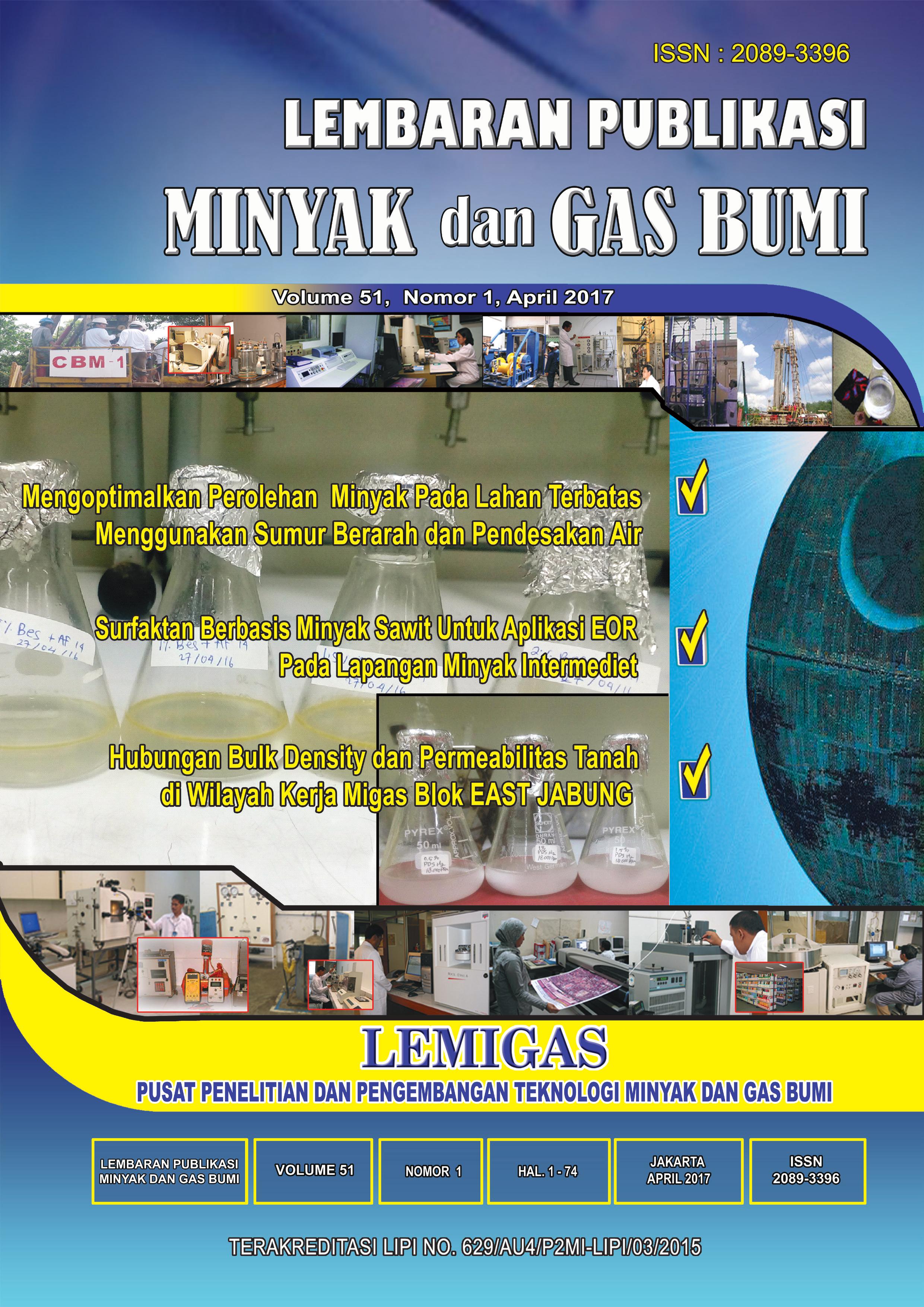FAKTOR YANG MEMPENGARUHI PRESISI DAN AKURASI DATA HASIL UJI DALAM MENENTUKAN KOMPETENSI LABORATORIUM (The Factor that Affect the Precision and Accuracy of Test Result Data within Determine the Laboratory Compentency Level)
DOI:
https://doi.org/10.29017/LPMGB.51.1.15Kata Kunci:
Akurasi, presisi, kompetensi laboratorium (Accuracy, precision, laboratory competence)Abstrak
Jaminan mutu hasil pengujian laboratorium yang dapat menentukan kompetensi laboratorium, antara lain dari hasil uji banding antar laboratorium atau uji profesiensi. Tujuan penelitian ini untuk mengetahui faktor-faktor yang mempengaruhi presisi dan akurasi data hasil uji dalam rangka penjaminan mutu laboratorium. Penelitian ini mengambil kasus penyelenggaraan uji profesiensi pelumas yaitu Asia Pacific Laboratory Accreditation Cooperation Proficiency Testing Programme yang diselenggarakan oleh Komite Akreditasi Nasional bekerjasama dengan PPPTMGB “LEMIGAS” pada tahun 2014 dengan parameter uji meliputi Viskositas Kinematik pada 40oC dan 100oC, Viskositas pada Suhu Rendah (Metode CCS), Angka Basa Total, serta Sifat Penguapan (Metode Noack). Hasil evaluasi menunjukkan bahwa data hasil uji yang tidak memuaskan untuk parameter viskositas 40oC dan 100oC masing-masing adalah 19,51% dan 10.26%, TBN 8,00%, CCS 5,56% dan untuk Sifat Penguapan (Metode Noack) seluruhnya memuaskan. Sedangkan %RSD paling rendah adalah viskositas kinematik pada 40oC sebesar 0,5516 dan %RSD paling tinggi yaitu sifat penguapan metode noack sebesar 7,048. Data hasil uji dengan nilai %RSD kecil mempunyai tingkat presisi dan akurasi yang lebih baik, sehingga kumpulan data tersebut sangat sensitif terhadap perbedaan nilai dan mudah masuk dalam kategori outlier. Faktor–faktor yang mempengaruhi presisi dan akurasi data adalah pemilihan metode uji, kompetensi personil, kalibrasi atau verifikasi alat uji serta penggunaan bahan kimia yang tepat. Presisi dan akurasi data hasil uji menentukan tingkat kompetensi laboratorium, hal ini dapat dicapai apabila sistem manajemen mutu telah diimplementasikan secara efektif dan konsisten.
The competence of a laboratory is supported by its quality assurance which is affected, the results of interlaboratory comparisons or profi ciency testing. The objective of this study to determine the factors that affect the precision and accuracy of test result data in the framework of laboratory quality assurance. This study was carried out using the case of lubricants profi ciency testing namely Asia Pacific Laboratory Accreditation Cooperation Proficiency Testing Programme organized by the National Accreditation Committee in cooperation with PPPTMGB “LEMIGAS” in 2014, profi ciency testing parameters include Kinematic Viscosity at 40°C and 100°C, Viscosity at Low Temperature (CCS Method), Total Base Number (TBN), and Evaporation Loss (Noack Method). The evaluation of the results indicate that the test results which are not satisfactory for the viscosity parameter at 40°C and 100°C are 19.51% and 10.26% respectively, TBN is 8.00%, CCS is 5.56%, whereas for evaporation loss (Noack Method), all the results are satisfactory. Whereas the lowest %RSD is kinematic viscosity at 40°C0.5516 and the highest is evaporation loss (Noack Method) 7.048. The data with lower %RSD have better precision and accuracy level, as a result the aggregate of the data are very sensitive to the value disparity. More over these data are much easier to enter the outlier category. The factors that affect the precision and accuracy data include selection test method, personnel competency, callibration or verifi cation of the equipment, and using appropriate chemical reagent. The precision and accuracy of the data indicating that the laboratory competency level are accessible, if the effectiveness and consistency of quality manajemen system have already implemented.
Referensi
Anonymous. (2015). Final Report (Amendment) [Reissued: May 25th, 2015] APLAC T091. Analysis of Lubricants. APLAC Proficiency Testing Programme.
Anto Dayan. (2000). Pengantar Metode Statistik. Jilid I. LP35, Jakarta.
ASTM. (2015). ASTM D445-15a, Standard Test Method for Kinematic Viscosity of Transparent and Opaque Liquids (and Calculation of Dynamic Viscosity). ASTM International. West Conshohocken, PA.
ASTM. (2014). ASTM D7042-14, Standard Test Method for Dynamic Viscosity and Density of Liquids by Stabinger Viscometer (and the Calculation of Kinematic Viscosity). ASTM International. West Conshohocken, PA.
ASTM. (2015). ASTM D2896-15, Standard Test Method for Base Number of Petroleum
Anonymous. Products by Potentiometric Perchloric Acid Titration. ASTM International. West Conshohocken, PA.
ASTM. (2011). ASTM D4739-11, Standard Test Method for Base Number Determination by Potentiometric Hydrochloric Acid Titration. ASTM International. West Conshohocken, PA.
ASTM. (2015). ASTM D5293-15, Standard Test Method for Apparent Viscosity of Engine Oils and Base Stocks Between –10 °C and –35 °C Using Cold-Cranking Simulator, ASTM International. West Conshohocken, PA.
ASTM. (2015) ASTM D5800-15a, Standard Test Method for Evaporation Loss of Lubricating Oils by the Noack Method. ASTM International. West Conshohocken. PA.
Badan Standarisasi Nasional. (2008). SNI ISO/IEC 17025:2008 - Persyaratan Umum Kompetensi Laboratorium Penguji dan Laboratorium Kalibrasi. BSN
Chen C. L., Wang J.J., Chiu H. S. (2013). Profeciency testing criteria for clearance level in solid waste gamma measurement in Taiwan. Applied Radiation
and Isotopes, 81: pp. 32-35.
Heuillet, M, Lalere B., Peignaux M., De Graeve J., Vaslin-Reimann S., Pais De Barros J.P., Gambert P., Duvillard L. dan Delatour V. (2013). Validation of a reference method for total cholesterol measurement in human serum and assignation of reference values to profeciency testing samples. Clinical Biochemistry, 46(4-5), pp. 359-364.
Hilman Syaeful Alam. (2014). Evaluasi Unjuk Kerja Kalibrator Torsi Statik Hasil Rancang Bangun Melalui Uji Banding Kalibrasi. Jurnal Standardisasi, Volume 16, Nomor 3, hal 177 – 186.
ISO. (2005). ISO 13528:2005, Statistical methods for use in profeciency testing by interlaboratory comparisons.
Komite Akreditasi Nasional. (2011). KAN-P-06, KAN Policy on Profeciency Testing. Issued Number 4. KAN.
Mulyono, Sukadi, Rosidi, Sihono, Bambang Irianto. (2011). Akurasi Metoda Analisis Aktivasi Neutron pada Pengujian Se dan As Dalam Limbah Padat.Prosiding Seminar Penelitian dan Pengelolaan Perangkat Nuklir, Buku II, hal 301-307.
Nurhadi, Agus. (2012) Modul Pelatihan Validasi Metode Uji. AN Training.
Ulfiati, Ratu. (2010). Peran Laboratorium Pengendalian Mutu Dalam Menjamin Kualitas Produk Pelumas. Lembaran Publikasi LEMIGAS, Vol. 42, No. 2, hal 198-203.
Saeful Yusuf. (2013). Pengelolaan uji banding antar laboratorium menggunakan SRM dan calon SRM. Prosiding Seminar Nasional TAN 2013, PTAPB BATAN Yogyakarta.
SNI ISO/IEC 17043:2010/Amd1:2015, Penilaian Kesesuaian-Persyaratan Umum Uji Profesiensi. Badan Standardisasi Nasional.











